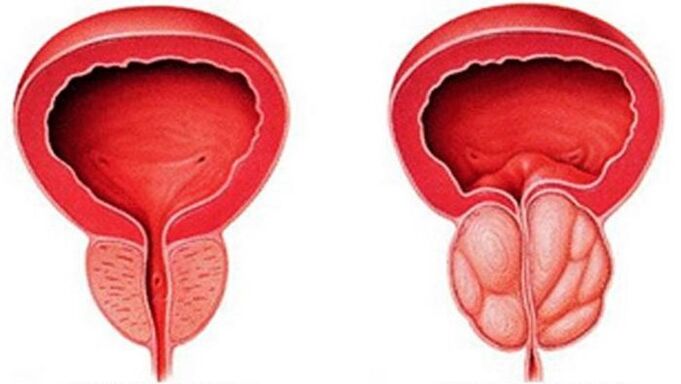Acute prostatitis is the most common disease in men. It is most commonly diagnosed between the ages of 30 and 50 in almost 60% of the male population.
In the acute form of prostatitis, an inflammatory process develops in the prostate. Several groups of drugs, prostate massage, physiotherapy are used to treat this stage of the disease. The most important thing in treatment is to prevent the pathology from turning into a chronic form.
Acute prostatitis in men and the reasons for its development
Acute prostatitis is the development of an inflammatory process in the prostate caused by the penetration of infection.
The disease is accompanied by swelling and suppuration in the prostate tissues.
This is the most common disease of men, which is accompanied by disorders of sexual function and fertility, disorders of psycho-emotional state, as well as social maladaptation.

Forms of acute prostatitis
The development of acute prostatitis goes through 4 stages, which are at the same time its forms:
- catarrhal;
- follicular;
- parenchymal;
- abscessing.
The disease begins with the development of catarrhal inflammation, which causes changes in the mucous and submucosal layer of the excretory ducts of the gland. Edema of the canal walls causes stagnation of mucopurulent secretions in the prostate follicles. The inflammatory process begins to progress, causing focal suppuration of the lobules of the prostate. Acute follicular prostatitis forms.
Multiple damage to the lobules of the gland, structural changes in the tissues of the prostate and the development of purulent-inflammatory process in them lead to the next stage of the disease - the parenchyma.
When many foci of inflammation merge into one large one, a prostate abscess develops. There is a possibility of opening in the urethra, perineum, rectum or bladder cavity.
Reasons for the development of diseases
The following factors can cause acute prostatitis in men:
- Infectious processes in the genitourinary system. Infectious agents (gram-negative and gram-positive) can penetrate prostate tissues: Escherichia coli, Proteus, staphylococci, streptococci. In many cases, the acute form of the disease can be caused by urogenital infections, such as: ureaplasmosis, chlamydia, mycoplasmosis, gonorrhea, candidiasis, etc.
- Infectious processes that enter the urethra through the urethra. Microbes can enter prostate tissue through the excretory ducts of the prostate that open into the urethra. That is why every type of inflammation of the bladder is accompanied by acute prostatitis in men.
- Infectious processes that enter the gland through the blood. The penetration of the infection into the prostate through the blood supply system is a consequence of its widely developed system of arterial and venous fusion. In this case, microbes are transmitted through the vascular system from distant foci of purulent inflammation in diseases such as tonsillitis, caries, sinusitis, bronchitis, cholecystitis, etc.
- Sedentary lifestyle. As a result of low motor activity, stagnation of prostate juice is formed. This facilitates: prolonged work at the computer, infrequent walks in the fresh air, smoking and drinking alcohol, infrequent sex, refusal of active rest.
- Hypothermia. Prolonged exposure to cold on the genitourinary system causes disturbances in the blood supply, which leads to stagnation of the prostate, which causes acute prostatitis.
- Pelvic and prostate injuries. Injury causes difficulty in the release of prostate secretion, which leads to the development of an inflammatory process that later causes acute prostatitis.
- Medical procedures. The acute form of prostatitis can develop as a result of chemotherapy or radiation therapy, as well as after medical examinations through the urethra.
Symptoms
The clinical picture of acute prostatitis is characterized by the presence of the following signs:
- Difficulty urinating
- feeling of incomplete bladder emptying;
- occurrence of frequent urges to urinate;
- itching and tingling;
- painful dull pain in the head of the penis, radiating to the anus (as the pathology develops, the pain will become chronic);
- pain during the act of defecation;
- increased body temperature (from 37 to 40 degrees - depending on the stage of disease development);
- decreased sex drive;
- erection problems;
- the content of traces of pus and blood in the urine;
- deterioration of general well-being.
Treatment
Acute prostatitis, unlike the chronic form of the disease, responds well to therapy. Serious complications are very rare.
The most important task of drug treatment is to free the patient from the pain syndrome and the cause of the pathology, to restore the normal process of urination.
Drugs used in the treatment of acute prostatitis:
- AntibioticsThe main group of drugs in the treatment of acute prostatitis. To choose an antibiotic, the doctor must accurately determine the cause of the disease. A combination of antibiotics is usually prescribed, when one drug is taken in the course, after which it is replaced by another. This approach minimizes the development of re-inflammation and prevents the transition from acute to chronic forms of the disease. Antibiotics-fluoroquinolones, tetracyclines, penicillins are used successfully.
- Diuretics Diuretics are prescribed to facilitate the urination process and reduce stress. Diuretics stimulate regular and volumetric urination. Medicines and herbal diuretics are used.
- Antipyretic. They are used to reduce body temperature, relieve pain in the joints and head.
- Antispasmodics. Smooth muscle relaxants relieve cramps. Also, drugs from this group relieve pain and help relieve urination.
- Alpha blockers. Medications that relieve cramps well, stimulate and facilitate the removal of urine from the patient.
After removing the main symptoms of the disease, prostate massage and physiotherapy procedures can be additionally prescribed.
After recovery, you must lead a healthy lifestyle.
Properly chosen treatment and adherence to all doctor's prescriptions will eliminate acute prostatitis and prevent it from becoming chronic.






























